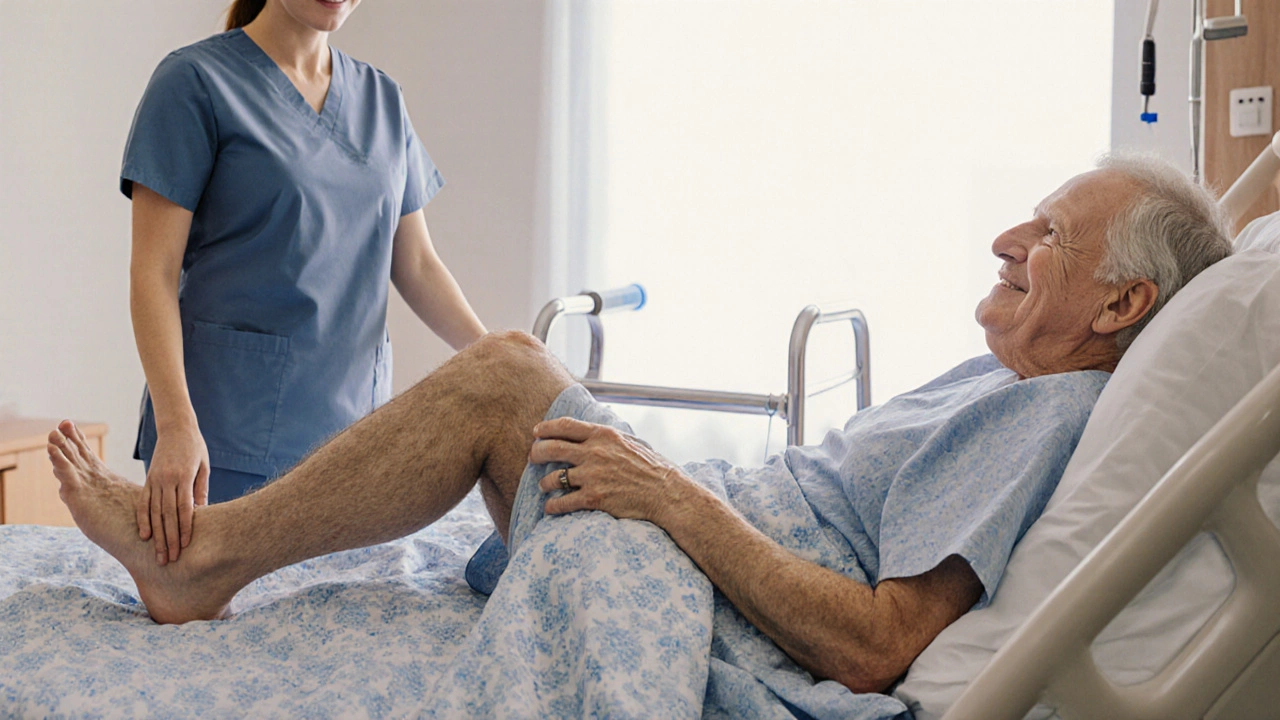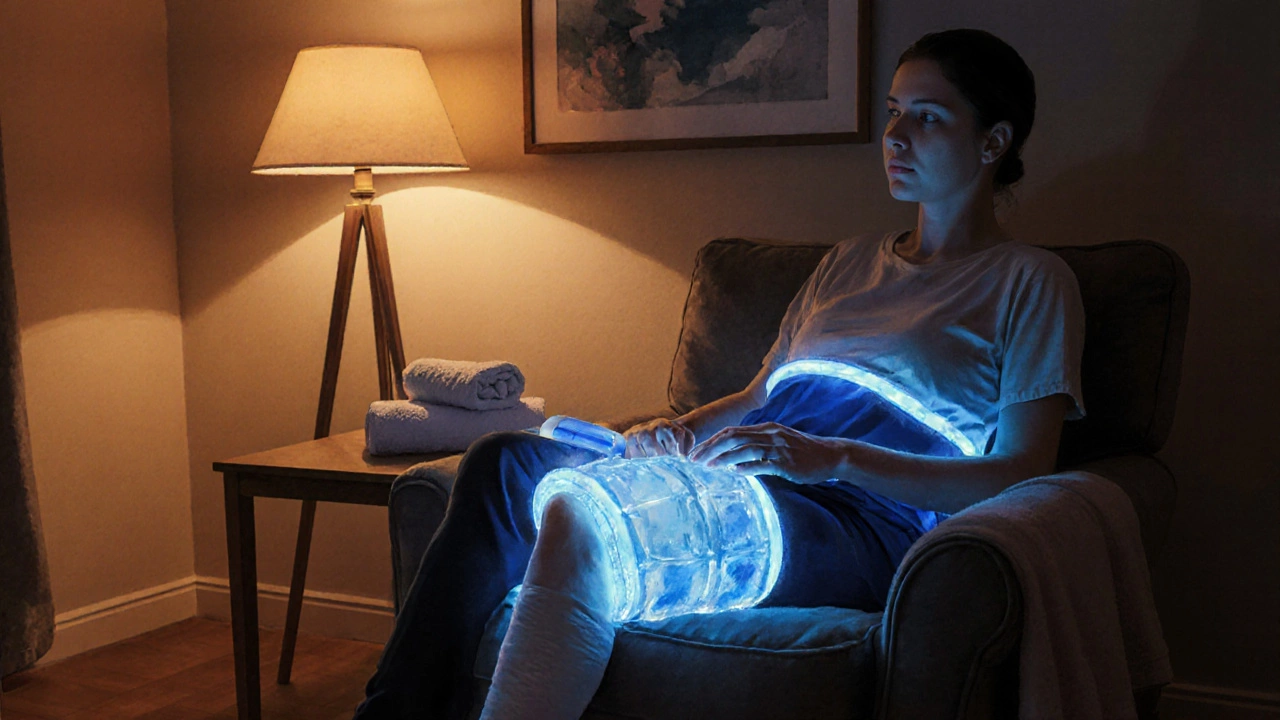- Home
- ::
- Fastest Ways to Recover From Knee Replacement Surgery

Fastest Ways to Recover From Knee Replacement Surgery
Knee Replacement Recovery Tracker
Estimated recovery time: 3-6 months
Weekly Milestones
- Week 1-2 Activate muscles, prevent stiffness
- Week 3-4 Build strength, improve range
- Week 5-6 Prepare for functional activities
You've just had a knee replacement and the first thing on your mind is getting back on your feet - fast. While every body heals at its own pace, there are proven steps that can shave weeks, even months, off the typical recovery timeline. Below you’ll find the most effective strategies, from the moment you leave the operating room to the day you jog without pain.
Understanding What Recovery Looks Like
Recovery after Knee Replacement Surgery is a procedure that replaces damaged joint surfaces with a prosthetic implant to restore function and relieve pain follows a predictable phases: immediate post‑op, early rehab, and functional strengthening. Most patients hit the 6‑week mark with basic walking ability, but true confidence usually arrives around 3‑6 months. Knowing the milestones helps you spot the shortcuts that accelerate progress.
1. Early Mobilization - Move Within Hours
The single biggest factor in a speedy comeback is getting the joint moving as soon as medically safe. Studies from the American Academy of Orthopaedic Surgeons show that patients who start Physical Therapy a supervised program focusing on strength, flexibility, and gait training within the first 24 hours experience less swelling and regain range of motion faster.
- Ask your surgeon for a clear mobility order before you even enter the recovery room.
- Begin with ankle pumps and quadriceps sets while still in bed.
- Progress to assisted standing using a walker or crutches under therapist supervision.
These tiny, frequent motions keep the synovial fluid circulating, preventing scar tissue from locking the joint.
2. Cryotherapy - Ice That Works
Swelling is the enemy of speed. Applying cold compresses or a continuous Cryotherapy controlled cooling treatment that reduces inflammation and pain for 20 minutes every 2‑3 hours during the first 48 hours can cut edema by up to 30 %.
- Use a gel pack wrapped in a thin towel - never direct ice on skin.
- For hands‑free cooling, consider a portable cuff that cycles temperature.
- Combine ice with gentle compression to further limit fluid build‑up.
Remember to monitor skin colour; if it turns white or numb, give the area a break.
3. Pain Management - Stay Comfortable, Stay Active
Effective pain control is the backbone of early activity. Over‑reliance on opioids can slow recovery through dizziness and constipation. Instead, aim for a multimodal regimen:
- Acetaminophen around the clock for baseline relief.
- Scheduled NSAIDs (if no contraindications) to curb inflammation.
- Local anesthetic blocks administered by the surgeon for the first 24 hours.
- Occasional low‑dose opioids for breakthrough pain only.
Talk to your pharmacist about Blood Thinners medications like aspirin or warfarin that prevent clot formation post‑surgery; they can affect bruising and swelling, so timing matters.
4. Nutrition - Feed the Healing Process
Your body needs fuel to rebuild bone and soft tissue. Focus on protein, vitamin C, zinc, and omega‑3 fatty acids. A simple daily plan could look like:
- Breakfast: Greek yoghurt with berries and a sprinkle of chia seeds.
- Lunch: Grilled salmon salad with mixed greens, avocado, and olive oil.
- Snack: A handful of almonds or a protein shake.
- Dinner: Lean chicken stir‑fry with broccoli and quinoa.
Stay hydrated - aim for 2‑3 liters of water a day - because fluids support cartilage lubrication and waste removal.

5. Home Rehabilitation Program - Consistency Beats Intensity
Once you’re discharged, the real work begins at home. A structured program that blends therapist‑guided sessions with self‑directed exercises yields the fastest gains.
| Week | Exercise Focus | Frequency | Goal |
|---|---|---|---|
| 1‑2 | Quad sets, heel slides, ankle pumps | 3‑4 times daily | Activate muscles, prevent stiffness |
| 3‑4 | Straight‑leg raises, gentle stationary bike | 2‑3 times daily | Build strength, improve range |
| 5‑6 | Wall sits, step‑ups, light resistance bands | 1‑2 times daily | Prepare for functional activities |
Track progress in a simple log: note pain level (0‑10), distance walked, and any swelling. Adjust the routine based on those numbers, not on an arbitrary schedule.
6. Walking Aids - Choose Wisely
Crutches, walkers, and canes each serve a purpose. Early on, a walker offers the most stability, reducing knee load by up to 60 %. As you regain confidence, switch to a cane to encourage a more natural gait.
- Make sure the device is height‑adjusted - your elbow should be at a 20‑degree bend.
- Practice proper heel‑to‑toe stepping to avoid falls.
- Discard the aid only when you can walk 30 minutes without pain.
7. Joint Mobilization - Gentle Hands‑On Techniques
Manual therapists use low‑force movements to improve joint glide. When performed by a licensed Physical Therapist, these techniques can increase flexion by 5‑10 degrees within two weeks.
Ask your therapist about “passive range of motion” sessions, especially if swelling limits your active attempts.
8. Prosthetic Knee Type - Does It Matter?
Modern implants come in cemented, cementless, and hybrid formats. While the surgeon’s choice is based on bone quality, certain designs (e.g., low‑profile inserts) allow a quicker return to low‑impact activities. If you’re an avid cyclist or hiker, discuss “high‑flex” options that permit deeper bending without extra wear.

Putting It All Together - Your 30‑Day Accelerated Plan
Below is a day‑by‑day checklist that blends the tips above into a realistic timeline. Tick each item off as you go.
- Day 0‑1: Ice every 2 hours, start ankle pumps, take prescribed pain meds, begin walking with a walker under therapist supervision.
- Day 2‑3: Add quad sets, continue cryotherapy, start low‑dose NSAIDs, begin protein‑rich meals.
- Day 4‑7: Increase walking distance by 10‑15 meters daily, start passive range of motion sessions, log pain and swelling.
- Week 2: Transition to stationary bike (5‑10 minutes), incorporate heel slides, evaluate need for blood thinners adjustment.
- Week 3‑4: Switch from walker to cane, begin straight‑leg raises, add light resistance bands, keep ice after each session if swelling recurs.
- Week 5‑6: Introduce step‑ups, wall sits, aim for 30‑minute low‑impact walk, schedule a therapist check‑in for joint mobilization.
Stick to the plan, listen to your body, and you’ll be surprised how quickly you regain independence.
Common Pitfalls and How to Avoid Them
- Skipping early exercises: Fear of pain leads many to stay in bed. Remember, pain is manageable with the right meds, and inactivity causes more swelling.
- Overusing opioids: They dampen the nervous system, making you less likely to move. Use them sparingly.
- Neglecting nutrition: A low‑protein diet stalls tissue repair. Aim for at least 1.2 g protein per kg body weight daily.
- Improper walking aid size: Too tall or short leads to bad posture and extra knee strain.
- Ignoring warning signs: Sudden sharp pain, fever, or calf swelling could signal infection or clot - call your doctor immediately.
When to Seek Professional Help
If after two weeks you can’t achieve a 70‑degree flexion, or if pain stays above 4/10 despite medication, schedule a follow‑up. Physical therapists can reassess your technique, while orthopaedic surgeons may need imaging to rule out complications.
Bottom Line: Speed Comes From Science + Consistency
The quickest path to a full, pain‑free knee isn’t a miracle shortcut; it’s a blend of evidence‑based practices applied every day. By moving early, controlling swelling, managing pain smartly, feeding your body right, and following a disciplined home rehab routine, you can shave weeks off the standard timeline and get back to the activities you love.
How soon can I start walking after knee replacement?
Most surgeons allow assisted walking with a walker within the first 24 hours, provided pain is controlled and the incision is stable.
Is cryotherapy safe for everyone?
It’s safe for most patients, but those with peripheral vascular disease, cold‑sensitivity, or open wounds should avoid direct ice and consult their doctor.
What foods boost knee healing?
High‑quality protein (lean meat, dairy, legumes), vitamin C (citrus, peppers), zinc (nuts, seeds), and omega‑3s (fatty fish, flaxseed) are key nutrients for tissue repair.
When can I stop using crutches?
Typically when you can walk 30‑40 meters without pain and have at least 90 degrees of knee flexion, usually around 4‑6 weeks post‑op.
Can I return to running after a knee replacement?
Most surgeons recommend low‑impact activities for the first year. Some patients resume jogging after 6‑12 months, but a high‑impact run may increase wear on the prosthetic.

 Health and Wellness
Health and Wellness





Write a comment